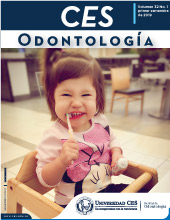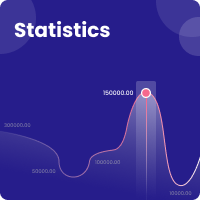Salivary glands: a clinical-histopathological study
DOI:
https://doi.org/10.21615/cesodon.32.1.2Keywords:
Salivary Glands, Pathology, Diagnosis, XerostomiaAbstract
Introduction and objective: The diseases that affect the salivary glands cover a wide range of conditions and etiologies, including infectious, inflammatory, immunological or neoplastic pathologies. The objective of this study was to identify the most frequent salivary gland diseases diagnosed in the School of Dentistry of Araraquara of the São Paulo State University (FOAr-UNESP). Materials and methods: This retrospective descriptive study included all cases of salivary gland diseases diagnosed between 2009 and 2013. In total, 2,236 clinical records of the Oral Medicine Service and 1,217 histopathological reports of the Histopathological Diagnosis Service were evaluated. Results: We identified 254 patients diagnosed with salivary gland disease, predominantly women (1.5 F / M). The most frequent diagnoses were mucocele (38.6%), sialolithiasis (6.7%), sialadenitis (5.1%), ranula (4.3%), Sjögren’s syndrome (2.8%), pleomorphic adenoma (1.2%) and mucoepidermoid carcinoma (1.2%). The most frequent histopathological diagnosis was the phenomenon of extravasation of mucus (85.2%). A common clinical finding was xerostomia (39%), mainly in patients treated with antihypertensive (42.4%), psychiatric (35.3%), anti-inflammatory (20.2%) and drugs for the treatment of gastric ulcers (13.1%). Conclusions: Our findings show the importance of a careful diagnosis, not only for neoplastic lesions, but also for pathologies of autoimmune, inflammatory and traumatic origin, which make up a greater number of cases. In addition, oral health professionals should be aware of the high frequency of xerostomia and its association with the use of certain medications, due to its negative impact on the quality of life of those suffering from this condition.
Downloads
References
Wolff A, Joshi RK, Ekström J, et al. A Guide to Medications Inducing Salivary Gland Dysfunction, Xerostomia, and Subjective Sialorrhea: A Systematic Review Sponsored by the World Workshop on Oral Medicine VI. Drugs R D. 2017; 17(1):1-28.
Nadig SD, Ashwathappa DT, Manjunath M, Krishna S, Annaji AG, Shivaprakash PK. A relationship between salivary flow rates and Candida counts in patients with xerostomia. J Oral Maxillofac Pathol. 2017; 21(2):316.
Diaz de Guillory C, Schoolfield JD, Johnson D, et al. Co-relationships between glandular salivary flow rates and dental caries. Gerodontology. 2014; 31(3):210-219.
Fox PC, Busch KA, Baum BJ. Subjective reports of xerostomia and objective measures of salivar gland performance. J Am Dent Assoc. 1987; 115(4):581-584.
Thomson WM, Brown RH, Williams SM. Medication and perception of dry mouth in a population of institutionalized elderly people. N Z Med J. 1993; 106(957):219-221.
Murray Thomson W, Poulton R, Mark Broadbent J, Al-Kubaisy S. Xerostomia and medications among 32-year-olds. Acta Odontol Scand. 2006; 64(4):249-254.
Niklander S, Veas L, Barrera C, Fuentes F, Chiappini G, Marshall M. Risk factors, hyposalivation and impact of xerostomia on oral health-related quality of life. Braz Oral Res. 2017; 31:e14.
Hopcraft MS, Tan C. Xerostomia: na update for clinicians. Aust Dent J. 2010; 55(3):238-244; quiz 353.
Fonseca FP, Carvalho M de V, de Almeida OP, Rangel AL, Takizawa MC, Bueno AG, et al. Clinicopathologic analysis of 493 cases of salivary gland tumors in a Southern Brazilian population. Oral Surg Oral Med Oral Pathol Oral Radiol. 2012;
(2):230-239.
Moreira ARO, Oliveira CDM, Figueirêdo EP, R.R. S, Lopes FF, Bastos EG. Epidemiology of salivary glands diseases in São Luís – MA – a survey of twenty years. RFO. 2009; 14(2):105-110.
Kramer IR, Pindborg JJ, Bezroukov V, Infirri JS. Guide to epidemiology and diagnosis of oral mucosal diseases and conditions. World Health Organization. Community Dent Oral Epidemiolog. 1980; 8(1):1-26.
Bettio A, Salgado G, L.R. A-A, Machado MAN, Grécio AMT, Lima AAS. Prevalence of salivary glands lesions from histopathologic diagnosis of Experimental Pathology Laboratory of PUCPR in the period of 1999-2008. Rev Sul-Bras Odontol. 2009; 6(3):231-236
Lukšić I, Virag M, Manojlović S, Macan D. Salivary gland tumours: 25 years of experience from a single institution in Croatia. J Craniomaxillofac Surg. 2012; 40(3):e75-81.
Lawal AO, Adisa AO, Kolude B, Adeyemi BF, Olajide MA. A review of 413 salivary gland tumours in the head and neck region. J Clin Exp Dent. 2013; 5(5):e218-222.
Araya J, Martinez R, Niklander S, Marshall M, Esguep A. Incidence and prevalence of salivary gland tumours in Valparaiso, Chile. Med Oral Patol Oral Cir Bucal. 2015; 20(5): e532–e539.
Sotelo-Gavito JJ, Pérez-Montaño M, Alderete-Vázquez G, Capetillo-Hernández G, Grube-Pagola P.Salivary gland tumors in Veracruz. Experience of two institutions. Rev Med Inst Mex Seguro Soc. 2018; 56(2):148-153.
Millsop JW, Wang EA, Fazel N. Etiology, evaluation, and management of xerostomia. Clinics in Dermatology. 2017; 35: 468–476.
Moritsuka M, Kitasako Y, Burrow MF, Ikeda M, Tagami J, Nomura S. Quantitative assessment for stimulated saliva flow rate and buffering capacity in relation to different ages. J Dent. 2006; 34(9):716-720.
Affoo RH, Foley N, Garrick R, Siqueira WL, Martin RE. Meta-Analysis of Salivary Flow Rates in Young and Older Adults. J Am Geriatr Soc. 2015; 63(10):2142-2151.
Downloads
Published
How to Cite
Issue
Section
License
Copyright (c) 2019 CES Odontología

This work is licensed under a Creative Commons Attribution-NonCommercial-ShareAlike 4.0 International License.
| Article metrics | |
|---|---|
| Abstract views | |
| Galley vies | |
| PDF Views | |
| HTML views | |
| Other views | |



